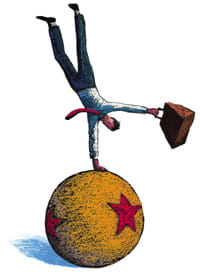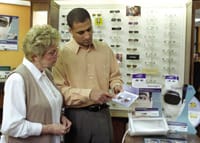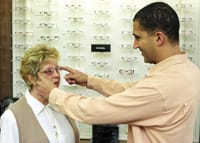Things are easier at
the top
Ten tips on selling frames and lens products from the top down
By Erinn Morgan

"It takes just as much time and effort to start with high-end or designer product," says Michael Della Pesca, FNAO, president of Quantum Optical, a consulting firm based in Haledon, N.J. "Review the features and benefits of a better-quality frame. Show the intricate detail or sturdiness. Let the patient feel the weight of the titanium. Use your sales skills to make the patient realize that premium product commands a premium price. Don't automatically assume the patient can't afford to upgrade to a better frame or thinner lenses."
Many eyecare professionals are embracing the top-down selling strategy, especially in the current retail climate, where price discounters like Wal-Mart have dominated the low-priced optical market. Thus, many are focusing on the premium products arena--and selling from the top down--to remain successful in an increasingly crowded optical retail marketplace.
Additionally, today's technology has pushed the industry into what some experts call "the ingredient era," where there are so many options in frames, lenses, and lens coatings that it is easy for customers to become overwhelmed. Thus, as part of the top-down strategy, some dispensers have focused on creating packages of lens materials and coatings to present the customer instead of selling products a la carte.
Still, many eyecare professionals are hesitant to dive into top-down selling, fearing they will jeopardize the sale--and their relationship with the customer. Certainly, dispensers do not want to start off showing a new customer a $1,200 gold frame with precious stone inlays.
|
|
|
|
Discussion, learning, and intuition can help dispensers decide what the appropriate starting point is for every patient who is shopping for new eyewear |
|
"It gets into a philosophical thing," says Al Shook, owner of Hearst opticians in Ft. Worth, Texas. "Our top-of-the-line is Swarovski crystal eyewear, and we don't start with that because it is way more expensive than anything else we carry. If we start with that, some people will be walking right out the door."
But there is an appropriate level to begin at with every customer. It is simply a matter of learning where this is with each different person--through discussion, learning, and intuition.
"You never start at the bottom because then you have to fight your way up," says Jeffrey Gitomer, a national expert on top-down selling and the author of The Sales Bible. "If you start with a $1,000 pair of frames, then $500 looks pretty good."
To help dispensers get started with top-down selling--or fine-tune some rusty skills--we present 10 tips for successfully starting at the top with your product presentation. And finishing there, too.
Committed to the top. The first move is to make a collective decision within the dispensary that all salespeople will now focus on presenting premium products first.
"We all definitely start on the upper end and work our way down," says Nicki Harrison of Advanced Vision Care in Bethel Park, Pa. "If you don't take the time with the patients to discuss and explain things, they will buy a simple frame and CR 39 lenses."
Certainly, it must be a concerted effort supported by both management and staff, as customers will not respond kindly to mixed messages during the product presentation.
Secondly, the dispensary should be stocked with products conducive to the top-down selling focus--and the customer demographic being served. This should include a range of high-end to lower-end frames, lens products, and lens coatings (i.e., UV, scratch-resistant, and anti-reflective add-ons).
Finally, any lens packages deemed appropriate for the customer base, such as high index lenses with anti-reflective and scratch coatings, should be organized and explained to the staff.
"My belief in top-down selling started from watching what other industries were doing with their products," says industry consultant Tim Fortner.
"Everybody was bundling and selling packages under one pricepoint. There was no doubt that consumers wanted this--they preferred a simple choice."
Once these items are set, eyecare professionals are prepared to roll into the next three steps of top-down selling.
Work with your lab and suppliers. These resources can supply you with invaluable information and advice on how to get started with top-down selling, says Fortner.
"I'd advise dispensers to talk to their suppliers and begin asking them questions about the best ways they have seen others do it--without revealing any confidential information from other offices, of course," he says.
What sort of investment does this entail? "Very little money would have to be invested to get this new strategy rolling, but dispensers would need to have a lens center in the dispensary. Samples for this are available through labs and suppliers as well," Fortner adds.
Wear it. If dispensers want customers to believe in the products they are presenting, there is no more convincing factor than if the eyecare professionals are wearing it themselves.
"The dispensing staff needs to wear the premium products when it applies to their prescriptions," says Fortner. "When the customer asks about a particular product, you can say, 'Talk to Jane; she wears them and loves them.' Everyone should have AR coating on their lenses as well. This way customers can see the difference and the staff can better talk about the benefits."
Present it. It sounds so simple, but it is still difficult for many dispensers to get in the habit of always starting at the top. Some quickly fall back into the habit of pre-judging customers who walk in the door and steering them to low-end product.
|
|
Especially in a tough economy, many eyecare professionals have a difficult time starting customers off with high-end product. "The heart strings are really pulled upon in a down economy," says Della Pesca. "A lot of people shy away from showing high-end merchandise because they can relate to how price-sensitive a customer might be in the current economic climate."
Nonetheless, part of good service is showing your patients all of the options, and helping them to get the product they need and want. "You are doing the customer a disservice if don't show them the best. I have had some patients walk in and say they want something to wear around the house, and then they buy a $250 pair of eyewear because they believe the features and benefits are right for them," he adds.
Size up your customer. One of the best skills you can have to succeed at top-down selling is the ability to understand who your customer is and what he or she might be interested in.
"You can't judge a book by its cover," says Della Pesca. "You need to sit down and talk with the customer a little bit before you begin presenting product. A bit of preemptive conversation can really steer you in the right direction."
When an informed opinion is set in your mind, aim slightly higher for your patient. "You should start two levels up from where your mind thinks this person is at," he recommends.
Many experts emphasize that customers cannot be judged by appearances, so do not steer them to frames priced in the area that you surmise they can afford. The key is to sit down and talk with them about the price of their last pair, about what they are looking for, and about how much they might be interested in special features.
"There's no one way to gauge what a customer is willing to spend," says Gitomer. "Sometimes the person is very wealthy but stingy. The only way to judge it is by having a conversation on a one-on-one basis. If you talk about their last pair of glasses, you might find they liked the fact they only cost $150. But they might say: 'I really like them but am actually looking for a better pair.' So based on the questions you ask and your personal judgments, you form an opinion. It is about information plus a gut feeling."
And don't let the visuals fool you, a glam image doesn't always mean a big sale. "Don't think if they are dripping with jewelry that they are willing to pay a lot. You have to question and engage them. The customers will tell you what they want," Gitomer says.
Just cause. In the same vein as sizing up the customer, dispensers should be relatively sure that the level of eyewear they are showing the customers is reasonable to present to them.
Nothing will turn customers off faster than believing the dispenser is trying to give them the hard sell. "You can sell them once or sell them forever," says Gitomer. "Sometimes it's not in your best interest to sell them your most profitable item."
By selling customers what's best for them, you ensure repeat business. "Otherwise, you will have sold your $500 frame and nothing more. There has to be a balance between what you want to earn and what you think is best," Gitomer says.
This philosophy applies to lenses as well as frames. Dispensers experienced with top-down selling say they only present premium lens options if it will benefit the customer. "If it's justified by their prescription and lifestyle, I would present high-end lens options," says Shook.
Explain the product. To justify the price of higher-end product to customers, dispensers need to focus on outlining the special features and benefits of that item. "We steer them to the better product first and discuss the features and benefits with them," says Harrison. "Eyewear is a major expenditure for people, so we show them what is newest and why it costs more"
Thus, it is critical that the dispensing staff be well-versed in the nuances of the product range. "We make sure our dispensers know all the new products--we have them read the industry journals, and our frame and lens reps teach them about new products. I am lucky I have good dispensers who love what they do and want to learn about everything. They get excited about new products," adds Harrison.
|
|
|
|
Speaking to patients on a one-to-one basis can help you form a true estimate of what they are looking
for |
|
Team up. Making top-down selling a team effort with the resident optometrist or ophthalmologist will further assist the process. If the discussion about premium lens and frame products begins in the exam room, customers will be prepped on the advantages when they reach the dispensary.
One important point: It is helpful for the doctor to pass the product selection authority on to the dispenser at the end of the exam. "The doctor's recommendation is powerful," says Fortner. "So the doctor has to give power to the dispenser at the end of the exam. One of the best systems I've ever seen is where the doctor had a light in the room that he turned off when the exam was over. That signaled the dispenser to come in and the doctor would discuss which products he was recommending to the patient. He would also ask the dispenser what else he recommends and if there was anything he missed. This is the passing of authority."
Dealing with price resistance. It is inevitable. Some customers will not be interested in paying the price commanded by high-end products. To successfully work with these customers, dispensers need only to keep stepping back the products they are presenting to the next price level until the customer finds what he or she wants.
In the case of lens packages, this also holds true and dispensers can lower the price step-by-step, removing items such as anti-reflective coating or polarization.
|
|
|
|
|
"Our dispensers will go through the items they have chosen and quote them a price for the overall package," says Harrison. "If the customer thinks it's too much, we back off on the AR or another coating."
A matter of principle. Some dispensers believe steering customers to high-end products first is philosophically incorrect, while others believe they are doing customers a disservice if they do not.
The bottom line: If you don't offer it, someone else will. Experts on top-down selling agree that today's market is focusing on premium products, and customers have the right to know all of their options. Those who choose to start at the top report increased business--and profits--in the high-end, premium product arena.
"We moved into a new facility six years ago and put in a lot more higher-end product in the newly remodeled dispensary," says Harrison. "We were very nervous about doing it, but it has been a very successful strategy for us."







